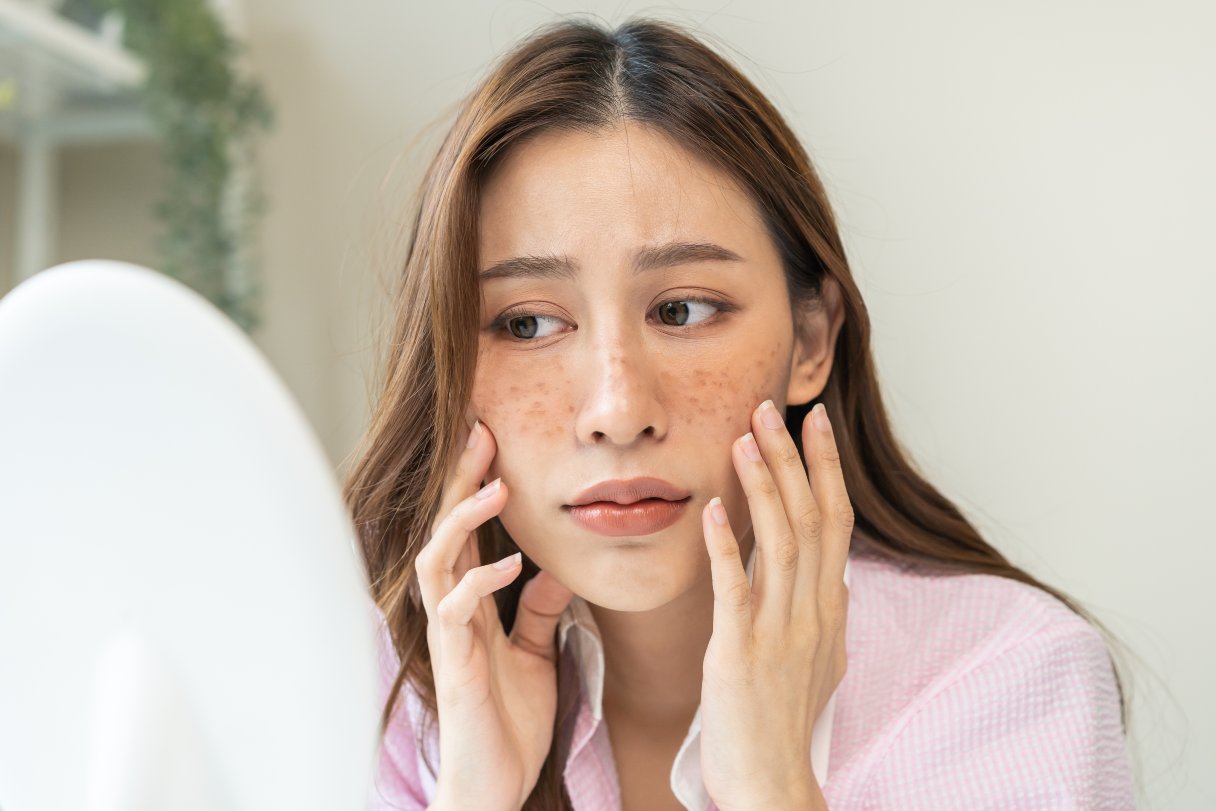If you notice brown or discolored spots suddenly appearing on your skin, chances are high that you're seeing sun spots. Sun spots on the skin are quite common, and there are a variety of ways to treat them if you want to minimize their appearance.
Common Causes of Sun Spots on Skin
Sun spots are a type of hyperpigmentation where you develop flat, painless, darker patches or spots on your skin due to excess melanin. This extra melanin is your skin's response to being damaged or unhealthy, typically due to sun exposure.1
Sun spots can appear on any areas of your skin that get sun exposure, like your face, hands, arms, the top of your feet or shoulders. They can be individual, small spots or they might be grouped together.2
Age spots vs. sun spots
Age spots are actually just another word for sun spots. They're also often referred to as liver spots or solar lentigines. Sun spots tend to be more common once you're 50 or older (hence the term "age spots"), but they can be found in younger people, too.2
Types of Hyperpigmentation
Sun spots are just one of many types of hyperpigmentation that can resemble one another.3 Here's a quick rundown of other types:3
- Birthmarks. These sometimes fade over time, but not always.
- Melasma. These are darker patches, most commonly on the face, caused by hormone changes (but sometimes by sun exposure, too).
- Post-inflammatory. Sometimes your skin may look darker (or lighter) in one spot after a trauma like a blister or a bruise.
- Skin rashes or infections. A rash or infection might sometimes look darker, but it's often accompanied by other symptoms, like raised patches, crusty or flaky skin or itchiness.
- Skin cancer. In rare cases, discolored skin might be a type of skin cancer, such as melanoma.3 These may be blacker, change size, bleed or have irregular borders.2
When to See a Doctor About Sun Spots
Sun spots are usually rounded or oval in shape and may even group together to appear larger and more noticeable.2 Anytime you notice changes in your skin or new, darker spots, it's important to see a doctor.2 While your symptoms may point strongly to sun spots, you'll need an official diagnosis to rule out skin cancer and ensure you're getting the right treatment.5
Your doctor may ask a number of questions, such as any type of medication you're taking, any medical conditions you have, other symptoms and when the darker spots first appeared. In some cases, your doctor might be able to diagnose sun spots from a visual examination only; in other cases, they may need to do a blood test or biopsy.1
Sun Spot Treatments and Costs
There are a variety of treatments for sun spots, depending on how severe your spots are. They range from home treatments you can buy at a store or online to treatments that require a prescription, or even outpatient procedures performed by a doctor.4
Prescription treatments for sun spots
Dermatologists offer a wide range of prescribed medications and procedures to choose from when it comes to treating sun spots. Creams are the least expensive, while treatments like cryosurgery or laser resurfacing are typically the most expensive. Here's a quick breakdown of the average costs, which can vary based on region, doctor or number of treatments needed.
| Sun Spot Treatment | Average Cost Range |
|---|---|
| Tretinoin cream | $103 to $2407 |
| Tri-Luma® cream | $206 to $2537 |
| Laser resurfacing | $1,445 (non-ablative) to $2,509 (ablative) per treatment8 |
| Dermabrasion | $1,296 average (but can range from $500 to $4,000)9 |
| Microdermabrasion | $167 per treatment10 |
| Chemical peel | $644 average (but can range from $200 to $6,000)11 |
| Cryotherapy | $100 to $499 per treatment12 |
The average costs listed for the procedures above are just for the procedures themselves and don't include extras like anesthesia (if necessary), operating room costs or other related expenses.9
Below is a more in-depth look at each of the treatments from the chart above.
- Tretinoin. While there are lower-dose retinoid creams you can get over the counter, tretinoin is a more potent version only available from your doctor.13
- Tri-Luma®. This prescription cream combines three ingredients that help lighten the skin: hydroquinone, tretinoin and fluocinolone acetonide.4
- Laser resurfacing. Laser treatments destroy cells beneath the surface that produce melanin. It may take two to three sessions to see results.5
- Dermabrasion. New skin is encouraged to grow when a mechanical brush is used to sand off age spots. It may take a few sessions to see results.5
- Microdermabrasion. Microdermabrasion is less powerful than dermabrasion but can help lighten spots.5 One study found that 40% of patients saw their age spots disappear completely when treated every other week for 16 weeks.6 Of those who had the procedure in conjunction with a chemical peel, 50% saw their spots disappear.6
- Chemical peels. A chemical solution removes the upper layer of your darker skin, encouraging new skin growth.5 Chemical peels are done every six to 12 months.5 About 47% of patients in one study saw their age spots fade by about 50%, but they had faster healing than those who did cryosurgery.6
- Cryotherapy. Your dermatologist will freeze off pigmented areas with liquid nitrogen, destroying excess melanin and encouraging lightening.5 In one study, people with cryosurgery had better results than chemical peels but slower healing.6
At-home treatments for sun spots
Several at-home treatments may help treat sun spots, including:5
- Over-the-counter creams. Options include creams with vitamin C, retinoic acid, azelaic acid, licorice extract, kojic acid or tranexamic acid. It can take one to three months with over-the-counter products to see results.
- Glycolic acid peels. These are less powerful versions of what you can get in a dermatologist's office. The solution removes a top layer of skin to promote new growth. They can be done every one to four weeks and might help lighten spots.
In the chart below are examples of the costs of some of these over-the-counter (OTC) treatments. Note that prices may vary depending on the retailer and brand.
| OTC Treatment | Average Cost |
|---|---|
| Azelaic acid cream | $3614 |
| Vitamin C serum | $19 to $5414 |
| OTC 2% hydroquinone cream | $5 to $2514 |
| OTC retinol-based product | $1614 to $13515 |
| Kojic acid and tranexamic acid product | $8814 to $10815 |
| Tranexamic and niacinamide serum | $43 to $16015 |
| Azelaic acid and glycolic acid | $74+15 |
| Glycolic acid (10%) serum | $33 to $4215 |
Note that the American Academy of Dermatology suggests consulting a dermatologist because it can be tough to narrow down all the over-the-counter options. The costs of trying different options can add up over time and might even end up costing more than a prescription.6
Does insurance cover prescription treatments for sun spots?
Unfortunately, health insurance is unlikely to cover sun-spot treatments.8 You may consider looking into financing options like the CareCredit credit card.
Tips for Preventing Sun Spots on Your Skin
Early intervention can help prevent sun spots from developing, which can save you quite a bit of money in the long run. If you have sun spots now, you can take these steps to help prevent new spots:2
- Wear sunscreen that is at least SPF 30, and put it on 15 to 30 minutes before you're in the sun. Reapply at least every two hours but more frequently if you're swimming or sweating.
- Try to avoid being outside between 10 a.m. and 2 p.m., when the sun is the most intense.
- Wear a hat with a wide brim to protect your face and clothing that covers your arms and legs to reduce exposure. Clothing with ultraviolet protection of SPF 40 or SPF 50 can help even more.
If you're unsure about sun spots on your skin, it's best to get a confirmed diagnosis from your doctor to ensure you're not mistaking them for something else.
CareCredit Credit Card Financing for Dermatology
The CareCredit credit card makes it easy to pay for dermatology visits, over-the-counter treatments and prescription medications at locations within the CareCredit network.* Start enhancing your skin today and find a dermatologist near you that accepts CareCredit. Continue your wellness journey by downloading the CareCredit Mobile App to manage your account, find a provider on the go and easily access the Well U blog for more great articles, podcasts and videos.
In addition to dermatology, you can also use your CareCredit credit card for other cosmetic procedures, dentistry, pet care, vision, hearing, health systems, dermatology, pharmacy purchases, spa treatments and so much more within the CareCredit network. How will you invest in your health and wellness next?
Author Bio
Stephanie Dwilson specializes in science journalism, breaking news and animal health and is a business owner, non-practicing attorney and writer.







